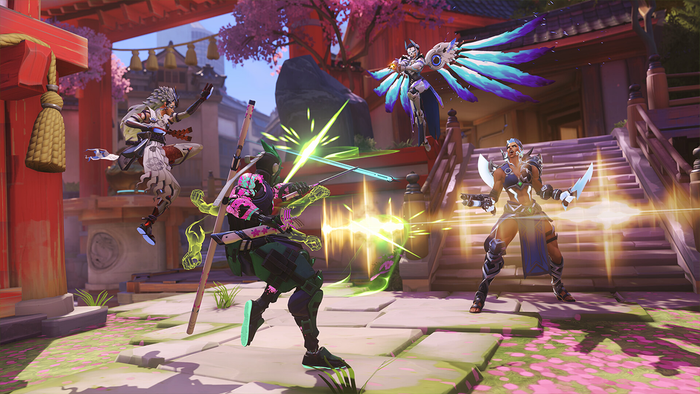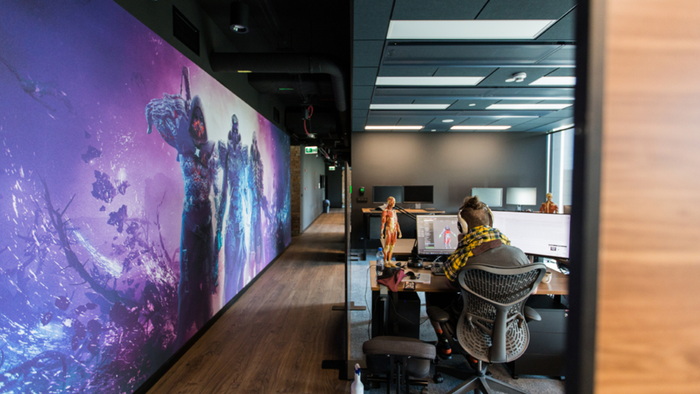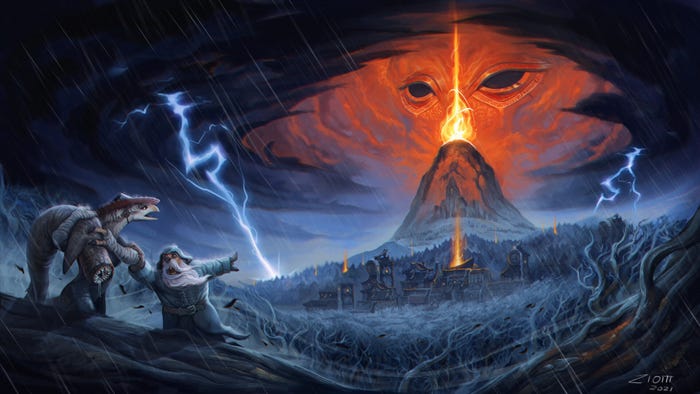At VRDC Fall 2017 in San Francisco today Adam Orth (Adr1ft), Chris Pruett (Robot Invader), Will Smith (Foo Show) and Dirk Van Welden (Space Pirate Trainer) shared advice on making immersive VR worlds.

Virtual reality has arrived, and many developers continue to struggle with one of its core challenges: how do you design a VR game or experience that makes players feel immersed in another world?
At VRDC Fall 2017 in San Francisco today, a panel of experienced VR devs took to the stage to share their own experiences crafting immersive VR worlds.
First Contact Entertainment’s Adam Orth opened the talk with some Guns N' Roses trivia: it's been nearly twenty years since Guns N' Roses released its seminal double album "Use Your Illusion", which Orth said the panel was named after.
“I like to infuse music into my talks somehow,” said Orth, holding up the Use Your Illusion albums as a breakthrough moment for the band. Nevertheless, “despite the global success of these albums and their tour, the double albums ended up splintering and destroying the band.”
“So, cautionary tale about double albums, guys,” said Orth. “And excess in video games, I guess.”
He tied it back to his own (18-year) career as a game developer, and how it seemed to fall apart a few years ago despite indicators of success.
“I was becoming embittered and just hostile towards the whole thing. I didn’t want to do it anymore. And I was just searching for whatever the new thing was," said Orth. "I didn’t know what to do. I was really stuck in a rut.”
Then, he started work on Adr1ft. For Orth, it was something of a reset -- in both career and life. He tried to tell a deeply personal story through an interactive experience, and he started doing it right when the Oculus Rift Kickstarter hit. Orth and his colleagues backed it, got a Rift development kit, and “I just lost my mind,” said Orth.
They built a prototype for the Rift, and while it was crude, Orth recalls feeling as though “everything fell into place. We were feeling around in the dark….but it took me someplace I could never go in real life. That’s when I really saw the power of VR.”
He acknowledges that from that point forward, he was hooked; he became an early adopter and an evangelist for VR. After Adr1ft shipped Orth joined First Contact to help lead their VR efforts, and he’s now focused on multiplayer VR experiences.
Space Pirate Trainer project lead Dirk Van Welden echoed much of what Orth said, relating a similar story of how he became a very early VR supporter when the Oculus Rift Kickstarter hit. However, his first experience with a VR game made him ill -- and almost turned him off VR dev for good.
“I’m super susceptible to motion sickness. I actually said to myself, 'I’m never going to create a VR game,'” he said. “2-3 years afterward I got the Vive, and I was blown away because I wasn’t getting motion sick….mainly because of the positional tracking.”
He says Space Pirate Trainer has now sold over 150,000 copies, a success for the small team developing it. Part of why it did well, he reasons, is because it’s set in a big open arena that players can look around at all times.
“One of the decisions we made was to have one environment, that is very open,” Van Welden said. “The thing is you want to create an environment that people want to look at, constantly."
Also, he cautioned devs against creating environmental complications that people can't explore themselves. So if your game doesn't have locomotion, don't put corners in the background of your world.
"You have to make sure people don’t feel like they’re missing out on stuff that’s happening around the world," Van Welden added.
Also, try not to creep people out by putting things behind them. An early prototype of Space Pirate Trainer was truly 360 -- enemies would fly around behind the player as often as they’d fly in front of them. But Van Welden said people felt more secure when targets were in front of them, and so the team recalibrated the game so that enemies tend to hang out in front of the player.
“You just don’t want to overwhelm them,” he said. “They can look around see the environment, but you don’t want to overwhelm them.”
Unlike the rest of the panelists, VR developer Will Smith doesn’t really make games: he makes (among other things) a VR talk show, the Foo show. For him, it's a chance to try and have warm, human conversations about intangible things like games and code.
“I wanted to be able to take these intangible assets people created, for games and science and other mediums, and have conversations with the creators inside these intangible spaces,” said Smith.
VR devs should note that the Foo show relies on hosts and guests (clothed in low-poly VR avatars) who can converse and move around an environment in real time. One of the earliest things Smith said he and his team learned about making VR avatars is that it’s way more important to design for believability, rather than accuracy.
“I didn’t know if you were gonna be able to believably interview someone using avatars,” he said, explaining that the team struggled with making seemingly simple things (like the joint between a VR avatar’s hand and forearm) not look off-putting. But when they simplified the avatars, it worked.
“It turns out taking 3 points of data and turning that into a believable animated human is...difficult,” said Smith. “But body language does come across, even with just 3 points of data...if I shrug in VR, it comes across much more clearly than in a Skype call or something like that.”
Finally, Robot Invader cofounder and Oculus staffer Chris Pruett acknowledged that his interest in immersive VR worlds -- and thus, his place on the panel -- came from a rare place: a deep-seated desire to scare the crap out of people.
“I don’t really care about jump scares or monster closets,” he said. “What I care about is an environment that you’re worried about. What I’m going for is what we call a ‘sense of presence’, something that horror game designers have been working on long before VR.”
Pruett said VR was great for horror freaks because the technology now delivers, by default, so much of that “sense of presence” that he and fellow horror game designers have been trying to cultivate for years. The rest of the panel agreed, especially Orth.
“When I was working on Adr1ft, I researched a lot...how people who go up into space feel,” said Orth. “What does it feel like, to look down on humanity? The one commonality was that they had a sense of presence, in space, that changed them forever. And I wanted to try and use VR to capture that.”
During the ensuing discussion the panelists wound up sharing a lot of potentially useful bits of advice for VR devs. Here are a few particularly salient excerpts:
Interactivity builds immersion
“We saw that in virtual environments, people try to interact with everything. You saw it in Job Simulator and other games...people do random stuff,” said Van Welden. “You have to try and predict what people will want to do, but of course you can’t predict everything.”
You do spend a lot of time on details people might not see, he acknowledged, but that time spent increases the fidelity of your virtual world -- and that’s what helps people feel immersed in it.
“You have an opportunity, with each new world, to write your own grammar,” added Pruitt, suggesting that the 'grammar’ of VR games and experiences is still being created. “You can use that opportunity to make something feel very immersive if you make sure that grammar is consistent.”
So, for example, if you let players pick up and throw certain objects in your world, you should let them pick up and throw everything; otherwise, they’ll be reminded that they’re playing in VR every time they try and fail to throw an immovable object.
Put effort into making sure things the player sees and interacts with often are high-detail
“Having stuff with high quality very close to you, and stuff with lower quality further away, just makes the whole experience better,” said Van Welden.
“We spent a lot of time detailing everything that’s very close to you,” said Van Welden. “The first thing people do in VR, when they’re holding an object, is they look at it very closely. So we spent a lot of time modeling the gun, because it gives a seal of quality.” Same goes for your floor textures, which are often relatively low-quality but appear surprisingly close to your player.
Don't skimp on audio and force feedback -- immersion is about more than visuals
“Don’t underestimate stuff like force feedback and audio,” said Van Welden. He says he spent a lot of time on the force feedback in Space Pirate Trainer, and thats one of the easily-missed reasons why it “feels good.”
“For a believable environment, audio is more importnat than your visuals,” said Pruett. “Properly done audio, with spatial and good headphones...you can sell an experience with just a black screen.”
If you don't get motion sick, find someone who does -- preferably on your team
"If you're not susceptiple to motion sickness, it's really good to have someone -- like Dirk -- who is," said Smith, nodding to Van Welden. This can help you identify nausea-inducing issues early, minimizing the chances that your players will have to de-immerse themselves out of your final VR game to go lie down.
About the Author(s)
You May Also Like









